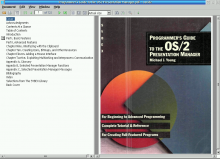Programmer's Guide To The OS/2 Presentation Manager - Michael J. Young
The Presentation Manager is the windowed graphics interface provided with the OS/2 Operating System, beginning with version 1.1.
Although implemented as an extension to the basic operating system, the Presentation Manager is central to the purpose of OS/2.
OS/2 was designed to run multiple programs, to allow communication among these programs, and to provide efficient interaction with the user.
The Presentation Manager uses the basic facilities of OS/2 to run multiple applications within windows on a single screen, to exchange data among these applications, and to coordinate their input and output operations. The Presentation Manager thus realizes the fundamental design goals of OS/2.
The Presentation Manager also provides uniform channels for communication and exchange of data among separate programs. Accordingly, applications written for this environment can easily coordinate their activities and exchange data in order to form integrated software Systems.
Unfortunately, however, developing an application for the Presentation Manager is not a trivial task for the programmer accustomed to traditional programming environments. There are two basic reasons for the initial difficulty in writing a Presentation Manager program. First, as you will see in this book, the basic architecture of a Presentation Manager application is radically different from that of a traditional program. Second, the Presentation Manager is designed to provide a sophisticated interface for a wide variety of graphics and text mode programs. Accordingly, the number of function calls it provides is vast, and many of these function calls accept a large and complex set of parameters and options. As you develop Presentation Manager applications, you will likely come to appreciate the variety and subtlety of control afforded by the Presentation Manager application program interface.
Initially, however, the complexity can form an obstacle to learning and using the system.
This book is written to help you overcome both of these difficulties.


This work is licensed under a Creative Commons Attribution 4.0 International License.
Add new comment